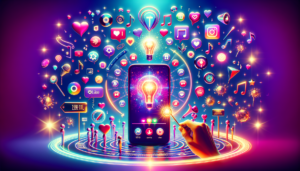The potential of AI chatbots is vast and powerful. These chatbots are powered by AI technology, which enables them to simulate human interaction and provide intelligent insights to users. As a result, they have become an essential platform for brands to engage with their audience.
One of the most significant advantages of AI chatbots is their ability to answer questions and offer personalized content to users. This makes them incredibly useful for individuals seeking information or assistance from a brand. With the advent of ChatGPT, an AI model that can answer questions based on natural language processing, AI chatbots have the capacity to offer more accurate and relevant answers than ever before.
As we enter a new era of AI-powered communication, the potential of AI chatbots to revolutionize how we interact with brands and consume content is greater than ever before. The capacity for these bots to learn from user interactions means that they will only continue to improve over time.
For brands looking to harness the power of AI chatbots, it’s essential first to understand what you want your bot to achieve. Whether it’s answering customer queries or providing personalized recommendations, having a clear goal in mind will help ensure your bot delivers value.
Another critical consideration when implementing an AI chatbot is ensuring it aligns with your brand’s tone and voice. While these bots can be incredibly helpful, they must also feel like an extension of your brand rather than a separate entity.
The current state of AI chatbots and their limitations
Limitations of AI Chatbots: Understanding Complex Human Emotions and Nuances in Language
AI chatbots have come a long way since their inception, but they still face limitations they often struggle with more complicated queries that require a deeper level of understanding. This is because many AI chatbots rely on pre-programmed responses, which may not be able to provide personalized solutions or handle unexpected situations.
One of the main challenges facing AI chatbots is their inability to understand human emotions. While some chatbots are equipped with sentiment analysis tools that allow them to detect positive or negative language, they still lack the ability to truly understand the meaning behind what someone is saying. For example, if someone says “I’m fine” in response to a question, an AI chatbot may interpret this as a positive response when in reality the person could be feeling upset or frustrated.
Another limitation of AI chatbots is their inability to pick up on nuances in language. Humans use sarcasm, irony, and other forms of figurative language all the time, but these can be difficult for an AI chatbot to detect. This means that even if someone is using clear language, an AI chatbot may still misinterpret what they are saying.
Data Quality and Algorithmic Limitations
The accuracy and effectiveness of AI chatbots can also be impacted by the quality of data they are trained on as well as the algorithms used to process that data. If an AI chatbot is trained on biased or incomplete data sets, it may not be able to provide accurate responses or solutions. If the algorithm used by an AI chatbot isn’t sophisticated enough, it may struggle with more complex queries.
For example, imagine a healthcare provider uses an AI-powered chatbot to answer patient questions about symptoms and treatment options. If the data set used to train the chatbot only includes information about a limited number of conditions, it may not be able to provide accurate responses for less common or more complex medical issues. Similarly, if the algorithm used by the chatbot isn’t sophisticated enough to detect patterns in symptoms or suggest potential diagnoses based on multiple factors, it may not be very effective at helping patients.
Security Concerns with AI Chatbots
Another concern with AI chatbots is their security. While they can be incredibly useful tools for businesses and organizations, they also present opportunities for malicious actors to exploit vulnerabilities in the technology. For example, hackers could use an AI chatbot to gain access to sensitive information or manipulate users into providing personal data.
To mitigate these risks, businesses and organizations need to ensure that their AI chatbots are secure and regularly updated with the latest security patches. They should only collect data that is necessary for providing services and take steps to protect that data from unauthorized access.
Predictions for the evolution and trends of AI chatbots
Personalized AI Chatbot Responses
 As AI chatbots continue to evolve, the trend towards personalization will become more prominent. Chatbots will be able to offer tailored responses to individual users based on their preferences, previous interactions, and even their location. This level of personalization will enhance the user experience and increase engagement with chatbots.
As AI chatbots continue to evolve, the trend towards personalization will become more prominent. Chatbots will be able to offer tailored responses to individual users based on their preferences, previous interactions, and even their location. This level of personalization will enhance the user experience and increase engagement with chatbots.
The use of natural language processing (NLP) technology in AI chatbots is a key factor in enabling this trend. NLP allows chatbots to understand and respond to more complex queries, making them more effective at providing personalized responses. As NLP technology continues to improve, we can expect AI chatbots to become even better at understanding human language and delivering relevant responses.
Integration with Other Technologies
Another trend that we can expect in the evolution of AI chatbots is increased integration with other technologies such as voice assistants and smart home devices. This integration will allow for a seamless user experience across multiple platforms and devices.
For example, a user could ask their voice assistant for information about a product, which would then trigger an AI chatbot to provide further details through a messaging app on their phone. This type of integration would make it easier for users to interact with businesses and brands through multiple channels.
Growth in Customer Service Use Cases
AI chatbots have already been widely adopted by businesses as a cost-effective solution for customer service. As the technology continues to improve, we can expect this trend to grow even further.
Chatbots are able to handle simple customer inquiries quickly and efficiently, freeing up human agents for more complex tasks. They can operate 24/7 without the need for breaks or time off, providing customers with round-the-clock support.
Efficient Multi-Tasking
One area where we can expect significant improvement in AI chatbot technology is multi-tasking. Currently, most chatbots are only capable of handling one conversation at a time. However, as the technology improves, we can expect chatbots to become more sophisticated in their ability to handle multiple conversations simultaneously.
This would significantly increase their efficiency and make them even more valuable for businesses looking to provide quick and effective customer support.
Emotional Intelligence
Finally, the development of emotional intelligence in AI chatbots is another trend that we can expect to see in the future. This technology would allow chatbots to better understand and respond to human emotions, making them more effective at providing personalized responses.
For example, a chatbot could detect if a user is feeling frustrated or angry and adjust its responses accordingly. This level of emotional intelligence would enhance the user experience and increase engagement with chatbots.
Advancements in natural language processing
Advancements in Natural Language Processing
Natural language processing (NLP) is a technology that has been around for decades, but recent advancements have made it more powerful than ever before. NLP enables computers to understand and interpret human language, including speech recognition and language understanding. In this section, we will discuss the latest advancements in NLP and how they are shaping the future of tech.
Speech Recognition
One of the most significant advancements in NLP is speech recognition. This technology allows computers to understand spoken language and convert it into text. Speech recognition has come a long way since its inception, with accuracy rates now approaching 95%. This technology has many applications, from voice assistants like Siri and Alexa to transcription services for journalists and doctors.
Language Understanding
Another area where NLP has made significant strides is in language understanding. Computers can now analyze text data to determine sentiment, intent, and even personality traits. This technology has many applications, from chatbots that can provide customer service to search engines that can better understand user queries.
Machine Learning Algorithms
To overcome the challenges of understanding human language nuances such as slang, idioms, and cultural references, NLP techniques rely on machine learning algorithms. These algorithms enable chatbots to learn from human interactions and improve their responses over time. As these algorithms become more sophisticated, chatbots are becoming more intelligent and capable of performing complex tasks such as customer service and search engine optimization with greater accuracy and efficiency.
Applications of NLP
The applications of NLP are vast and varied. Chatbots are being integrated into a wide range of devices such as smartphones, smart speakers, cars, and home appliances providing humans with powerful tools for communication and problem-solving. The healthcare industry is also using NLP for clinical documentation improvement (CDI), which helps medical professionals document patient care more accurately while reducing administrative burden.
Machine learning algorithms for chatbots
Machine learning algorithms are the driving force behind chatbot technology, allowing them to learn from user interactions and improve their responses over time. Powered chatbots use machine learning algorithms to analyze user data and provide personalized responses based on individual preferences and behavior. The use of chatbots has become increasingly popular in recent years, with businesses utilizing them to provide customer service, answer questions, and streamline communication.
One of the most important algorithms used in chatbots is deep learning. Deep learning allows chatbots to understand natural language processing and respond to complex queries with accuracy and speed. This algorithm uses neural networks that simulate the human brain’s ability to recognize patterns in data. By using this algorithm, chatbots can identify keywords or phrases within a sentence and determine their meaning based on context.
Another important algorithm used in chatbots is reinforcement learning. Reinforcement learning allows chatbots to learn from experience by rewarding or punishing certain actions based on their outcomes. For example, if a customer asks a question that the chatbot cannot answer, the bot can be programmed to seek out an appropriate response or escalate the issue to a human representative for further assistance.
Chatbots also use supervised learning algorithms which rely on labeled data sets for training purposes. These data sets contain examples of inputs (user queries) and outputs (chatbot responses) that have been previously labeled as correct or incorrect by humans. By analyzing these labeled examples, supervised learning algorithms can identify patterns in user behavior and adjust responses accordingly.
Unsupervised learning is another type of machine learning algorithm used in chatbots which does not rely on labeled data sets but instead identifies patterns through clustering or association analysis. This type of algorithm allows chatbots to group similar queries together for more efficient handling.
As machine learning technology continues to advance, so too will the capabilities of chatbots. With advancements in natural language processing and other AI technologies such as computer vision, it is likely that we will see even more sophisticated bots capable of handling complex tasks and providing more personalized experiences for users.
Conversational commerce and its impact on online sales
Customer Conversations and Interactions through Chatbots
Chatbots have revolutionized the way businesses interact with their customers. With conversational commerce, businesses can engage in customer conversations and interactions through chatbots on various social media platforms. This has enabled them to provide quick responses to customer inquiries, reducing costs by eliminating the need for human customer service representatives.
The use of chatbots has become increasingly popular as businesses recognize their potential to improve customer experiences and increase sales. Chatbots can collect feedback from customers during conversations, providing valuable insights for businesses to improve their products or services. The ability of chatbots to handle customer inquiries also ensures that businesses are always available to attend to their customers’ needs.
Social Media Platforms for Conversational Commerce
Social media platforms such as Facebook Messenger, WhatsApp, and WeChat have become popular channels for conversational commerce. These platforms offer a convenient way for customers to interact with businesses without having to leave the platform they are already using. Customers can easily initiate a conversation with a business by sending a message through any of these platforms.
Businesses can leverage social media platforms for conversational commerce by integrating chatbots into their operations. Kommunicate is one such platform that enables businesses to easily integrate chatbots into their customer service operations. With Kommunicate, businesses can create custom chatbot workflows that cater specifically to their needs.
Reducing Costs and Collecting Feedback through Chatbots
One of the main benefits of using chatbots is that they help reduce costs associated with human customer service representatives. By automating responses to frequently asked questions, chatbots reduce the workload on human representatives, allowing them more time to focus on complex issues that require human intervention.
Chatbots also enable businesses to collect feedback from customers during conversations. This provides valuable insights into how customers perceive the business’s products or services and what improvements can be made. Businesses can then use this feedback to make necessary changes that will improve overall customer satisfaction.
Enhancing customer experiences with AI chatbots
Enhancing Customer Experiences with AI Chatbots
Helping Customers with Queries
AI chatbots have revolutionized the way businesses interact with their customers. By providing quick and accurate responses, they have improved customer service and satisfaction. With the help of natural language processing (NLP), AI chatbots can understand customer queries and provide personalized solutions to their problems.
For instance, a leading e-commerce company uses an AI-powered chatbot to assist its customers in finding the right products. The chatbot asks questions about the customer’s preferences, budget, and style before suggesting relevant products. This not only saves time but also enhances the user experience by providing customized recommendations.
Providing Personalized Product Recommendations
One of the significant advantages of using AI chatbots is that they can offer personalized product recommendations based on a customer’s browsing history, purchase behavior, and preferences. This helps businesses to enhance the overall customer experience by providing tailored solutions to their needs.
For example, a popular music streaming platform uses an AI-powered chatbot to suggest songs based on a user’s listening history. The chatbot analyzes data such as genre preference, mood, and tempo to recommend songs that match the user’s taste.
Handling Large Volumes of Customer Support Requests
Another benefit of using AI chatbots is that they can handle large volumes of customer support requests simultaneously. This reduces wait times and improves the user experience by providing prompt solutions to their problems.
A case in point is a leading telecom company that uses an AI-powered chatbot to handle over 90% of its customer support requests. The chatbot provides instant solutions to common queries such as bill payments, plan upgrades, and network issues.
Understanding Customer Expectations and Experiences
With advancements in NLP technology, AI chatbots are becoming increasingly adept at interpreting customer expectations and experiences. This allows for more effective communication and problem-solving between businesses and their customers.
For instance, a popular airline company uses an AI-powered chatbot to assist its customers in booking flights, managing reservations, and resolving issues related to flight delays or cancellations. The chatbot uses NLP technology to understand the customer’s concerns and provide relevant solutions.
Empowering virtual assistants with conversational AI
Empowering Virtual Assistants with Conversational AI
Conversational AI is revolutionizing the way we interact with virtual assistants. By enabling these assistants to understand and respond to natural language, conversational AI makes them more intuitive and user-friendly. Voice assistants like Siri, Alexa, and Google Assistant are examples of virtual assistants that use AI to provide a more personalized service to users.
Enhancing Customer Service
Virtual assistants are becoming increasingly popular in customer service, with many businesses using AI-powered chatbots to handle customer inquiries and support requests. These chatbots can be programmed to recognize specific keywords and phrases in order to provide relevant responses to customers’ questions. This not only saves time for businesses but also provides a seamless experience for customers who may prefer interacting with a chatbot rather than waiting on hold for a human representative.
Improving Cybersecurity
The use of AI in virtual assistants can help improve cybersecurity by detecting and preventing potential threats in real-time. Conversational AI can analyze patterns of behavior and detect anomalies that could indicate an attempted breach or attack. By monitoring conversations between users and virtual assistants, conversational AI can identify suspicious activity such as phishing attempts or fraudulent requests.
Personalization
Conversational AI can also help virtual assistants learn from previous interactions with users, allowing them to provide more accurate and helpful responses over time. For example, if a user frequently asks their virtual assistant about the weather in their location, the assistant will learn this preference and automatically provide weather updates without being prompted.
Future Possibilities
As AI technology continues to evolve, virtual assistants will become even more sophisticated, offering a range of services beyond simple customer support. For example, they could be used as personal shopping assistants or travel agents that assist users in finding the best deals on flights and hotels based on their preferences.
Chatbots for HR and internal enterprise use
Chatbots for HR and Internal Enterprise Use
Streamlining communication within a company can be a daunting task, especially when dealing with repetitive tasks such as answering employee queries about company policies. However, with the rise of chatbots in the enterprise space, companies can now automate these mundane tasks, freeing up valuable time and resources. The chatbot industry is expected to grow significantly in the coming years, with more and more businesses adopting bots for internal use.
Recruitment and Onboarding
One area where chatbots are being increasingly used is in HR tasks such as recruitment and onboarding. Bots can help automate the process of screening resumes, scheduling interviews, and even conducting initial interviews. This not only saves time but also ensures that every candidate receives a consistent experience.
Onboarding new employees can also be streamlined through the use of chatbots. Bots can provide new hires with all the necessary information they need to get started, including details about company policies, benefits packages, and even introductions to key team members.
Efficient Communication
Another area where chatbots can be incredibly useful is in streamlining communication within a company. Rather than relying on lengthy email chains or phone calls, employees can simply ask their questions to a bot who will provide them with an immediate response.
This not only saves time but also helps ensure that everyone has access to the same information at all times. Chatbots can also be used to send out important announcements or reminders to employees across different teams or departments.
Remote Work
With remote work becoming increasingly common in today’s world, it’s more important than ever for companies to find ways to keep their employees connected and informed regardless of their location. Chatbots offer an ideal solution for this problem by providing a platform for real-time communication between team members.
Bots can be used to facilitate virtual meetings or brainstorming sessions, ensuring that everyone has an equal opportunity to contribute regardless of their physical location. They can also be used to provide remote workers with access to the same information and resources as their in-office counterparts.
The Future of Chatbots
As AI technology continues to advance, we can expect chatbots to become even more sophisticated, offering an even wider range of capabilities for enterprise use. For example, bots may soon be able to analyze employee data and provide personalized recommendations for career development or training opportunities.
Chatbots may also be able to assist with tasks such as performance evaluations or even conflict resolution between team members. As companies continue to adopt chatbots for internal use, it’s clear that these AI-powered tools will play an increasingly important role in the future of work.
The future of AI chatbots
In conclusion, the future of AI chatbots is incredibly promising. As we continue to create more advanced and sophisticated AI chatbots, we can expect to see them being incorporated into a wide range of applications and industries. From conversational commerce to HR and internal enterprise use, modern chatbots have the potential to revolutionize the way we interact with technology.
Advancements in natural language processing and machine learning algorithms are making it possible for AI chatbots to understand human language better than ever before. This means that they will be able to provide more personalized and accurate responses, leading to enhanced customer experiences.
As virtual assistants become increasingly popular, incorporating chatbots with artificial intelligence will empower them with conversational capabilities that make them even more useful. This will allow users to perform tasks quickly and efficiently without having to navigate through complicated interfaces or menus.




